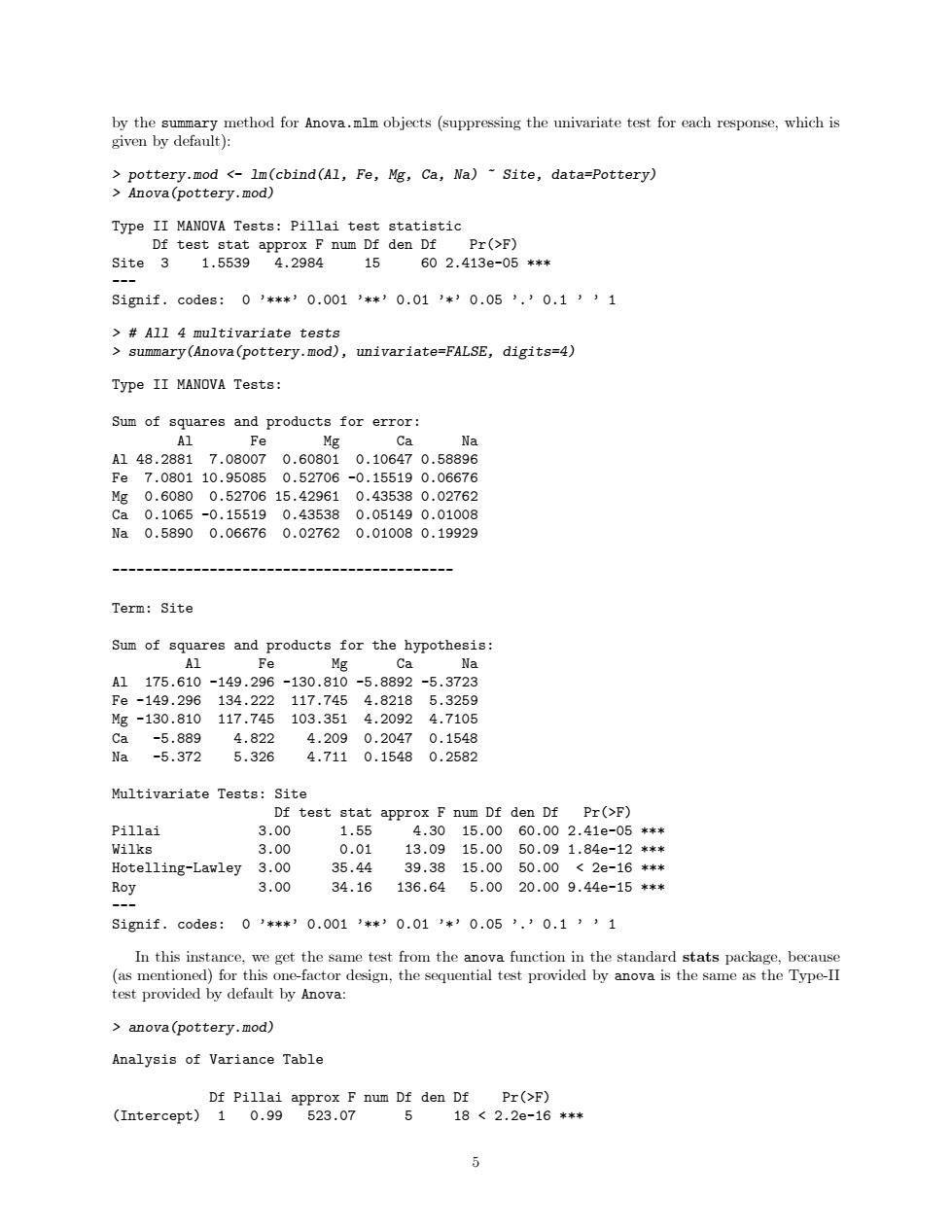正在加载图片...

by the summary method for Anova.mlm objects (suppressing the univariate test for each response,which is given by default): pottery.mod <-lm(cbind(Al,Fe,Mg,Ca,Na)~Site,data=Pottery) Anova(pottery.mod) Type II MANOVA Tests:Pillai test statistic Df test stat approx F num Df den Df Pr(>F) Site31.55394.2984 15 602.413e-05*** Signif.c0de8:0J**’0.0013*’0.01J*’0.05’.’0.1’’1 >All 4 multivariate tests summary(Anova(pottery.mod),univariate=FALSE,digits=4) Type II MANOVA Tests: Sum of squares and products for error: Al Fe Mg Ca Na A148.28817.080070.608010.106470.58896 Fe7.080110.950850.52706-0.155190.06676 Mg0.60800.5270615.429610.435380.02762 Ca0.1065-0.155190.435380.051490.01008 Na0.58900.066760.02762 0,010080.19929 Term:Site Sum of squares and products for the hypothesis: Al Fe Mg Ca Na A1175.610-149.296-130.810-5.8892-5.3723 Fe-149.296134.222117.7454.82185.3259 Mg-130.810 117.745 103.3514.20924.7105 Ca -5.889 4.822 4.2090.20470.1548 Na -5.372 5.326 4.7110.15480.2582 Multivariate Tests:Site Df test stat approx F num Df den Df Pr(>F) Pillai 3.00 1.55 4.3015.0060.002.41e-05** Wilks 3.00 0.01 13.0915.0050.091.84e-12*** Hotelling-Lawley 3.00 35.44 39.3815.0050.00<2e-16*** Roy 3.00 34.16 136.645.00 20.009.44e-15*** - Signif.codes: 03***10.0013**’0.013*’0.053.30.1331 In this instance,we get the same test from the anova function in the standard stats package,because (as mentioned)for this one-factor design,the sequential test provided by anova is the same as the Type-II test provided by default by Anova: anova(pottery.mod) Analysis of Variance Table Df Pillai approx F num Df den Df Pr(>F) (Intercept)10.99523.075 18<2.2e-16*** 5by the summary method for Anova.mlm objects (suppressing the univariate test for each response, which is given by default): > pottery.mod <- lm(cbind(Al, Fe, Mg, Ca, Na) ~ Site, data=Pottery) > Anova(pottery.mod) Type II MANOVA Tests: Pillai test statistic Df test stat approx F num Df den Df Pr(>F) Site 3 1.5539 4.2984 15 60 2.413e-05 *** --- Signif. codes: 0 ’***’ 0.001 ’**’ 0.01 ’*’ 0.05 ’.’ 0.1 ’ ’ 1 > # All 4 multivariate tests > summary(Anova(pottery.mod), univariate=FALSE, digits=4) Type II MANOVA Tests: Sum of squares and products for error: Al Fe Mg Ca Na Al 48.2881 7.08007 0.60801 0.10647 0.58896 Fe 7.0801 10.95085 0.52706 -0.15519 0.06676 Mg 0.6080 0.52706 15.42961 0.43538 0.02762 Ca 0.1065 -0.15519 0.43538 0.05149 0.01008 Na 0.5890 0.06676 0.02762 0.01008 0.19929 ------------------------------------------ Term: Site Sum of squares and products for the hypothesis: Al Fe Mg Ca Na Al 175.610 -149.296 -130.810 -5.8892 -5.3723 Fe -149.296 134.222 117.745 4.8218 5.3259 Mg -130.810 117.745 103.351 4.2092 4.7105 Ca -5.889 4.822 4.209 0.2047 0.1548 Na -5.372 5.326 4.711 0.1548 0.2582 Multivariate Tests: Site Df test stat approx F num Df den Df Pr(>F) Pillai 3.00 1.55 4.30 15.00 60.00 2.41e-05 *** Wilks 3.00 0.01 13.09 15.00 50.09 1.84e-12 *** Hotelling-Lawley 3.00 35.44 39.38 15.00 50.00 < 2e-16 *** Roy 3.00 34.16 136.64 5.00 20.00 9.44e-15 *** --- Signif. codes: 0 ’***’ 0.001 ’**’ 0.01 ’*’ 0.05 ’.’ 0.1 ’ ’ 1 In this instance, we get the same test from the anova function in the standard stats package, because (as mentioned) for this one-factor design, the sequential test provided by anova is the same as the Type-II test provided by default by Anova: > anova(pottery.mod) Analysis of Variance Table Df Pillai approx F num Df den Df Pr(>F) (Intercept) 1 0.99 523.07 5 18 < 2.2e-16 *** 5